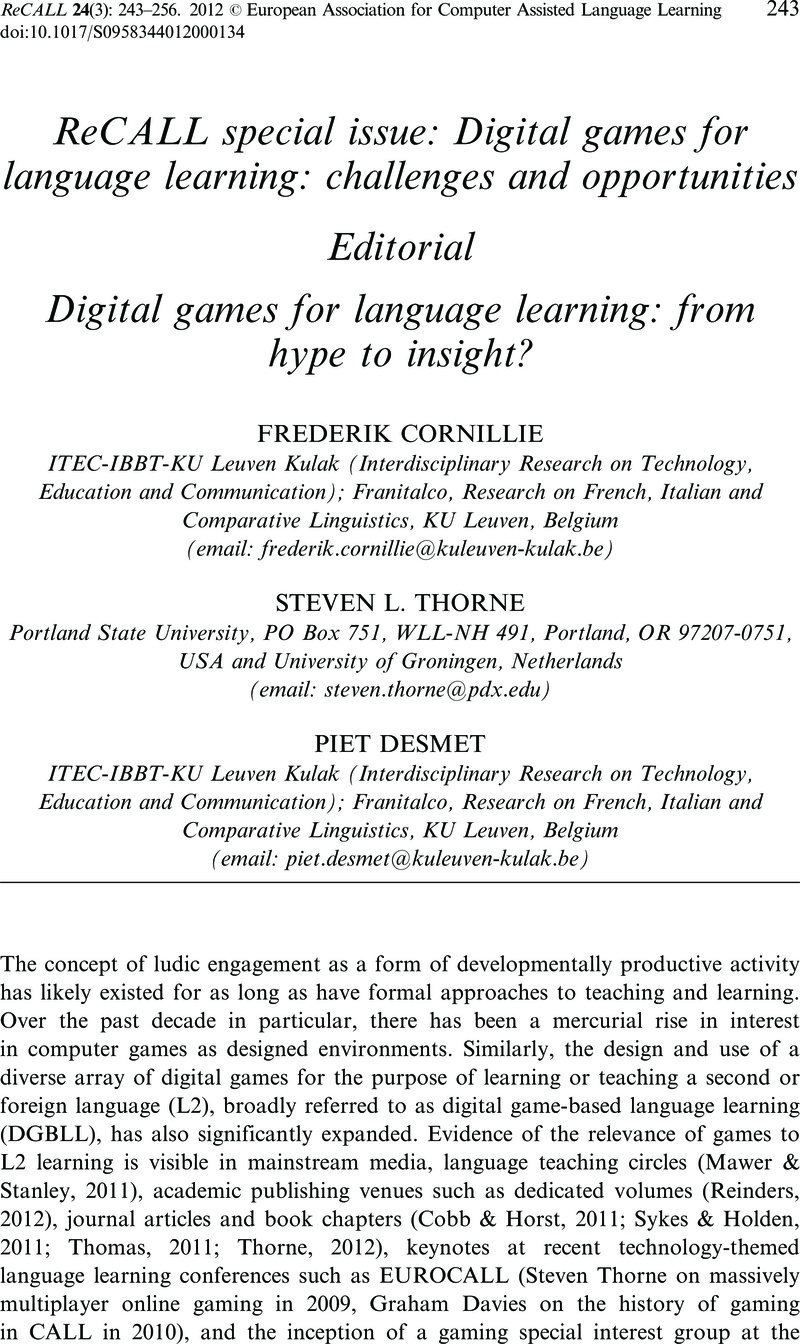Crossref Citations
This article has been cited by the following publications. This list is generated based on data provided by Crossref.
Vandercruysse, Sylke
Vandewaetere, Mieke
Cornillie, Frederik
and
Clarebout, Geraldine
2013.
Competition and students’ perceptions in a game-based language learning environment.
Educational Technology Research and Development,
Vol. 61,
Issue. 6,
p.
927.
Berns, Anke
Palomo-Duarte, Manuel
Dodero, Juan Manuel
and
Valero-Franco, Concepción
2013.
Scaling up Learning for Sustained Impact.
Vol. 8095,
Issue. ,
p.
19.
Chik, Alice
2013.
Naturalistic CALL and Digital Gaming.
TESOL Quarterly,
Vol. 47,
Issue. 4,
p.
834.
Pereira, Joe
2014.
International Perspectives on Materials in ELT.
p.
178.
Mroz, Aurore
2014.
21st Century Virtual Language Learning Environments (VLLEs).
Language and Linguistics Compass,
Vol. 8,
Issue. 8,
p.
330.
Pasfield‐Neofitou, Sarah
2014.
Language Learning and Socialization Opportunities in Game Worlds: Trends in First and Second Language Research.
Language and Linguistics Compass,
Vol. 8,
Issue. 7,
p.
271.
Schmidt, Inke
2014.
Evaluating Digital Applications for Language Learning: Outcomes and Insights.
p.
1.
Palomo-Duarte, Manuel
Berns, Anke
Dodero, Juan Manuel
and
Cejas, Alberto
2014.
Foreign language learning using a gamificated APP to support peer-assessment.
p.
381.
Piirainen–Marsh, Arja
and
Tainio, Liisa
2014.
Asymmetries of Knowledge and Epistemic Change in Social Gaming Interaction.
The Modern Language Journal,
Vol. 98,
Issue. 4,
p.
1022.
Gala, Núria
Billami, Mokhtar B.
François, Thomas
and
Bernhard, Delphine
2015.
Graded lexicons: new resources for educational purposes and much more.
p.
204.
Li, Ping
2015.
The Handbook of Language Emergence.
p.
511.
Loiseau, Mathieu
Zampa, Virginie
and
Rebourgeon, Pauline
2015.
Magic Word – Premier jeu développé dans le cadre du projet Innovalangues.
Alsic,
Vol. vol. 18, n° 2,
Issue. ,
Yudintseva, Anastassiya
2015.
Game-Enhanced Second Language Vocabulary Acquisition Strategies: A Systematic Review.
Open Journal of Social Sciences,
Vol. 03,
Issue. 10,
p.
101.
Yudintseva, Anastassiya
2015.
Synthesis of Research on Video Games for the Four Second Language Skills and Vocabulary Practice.
Open Journal of Social Sciences,
Vol. 03,
Issue. 11,
p.
81.
Sundqvist, Pia
and
Wikström, Peter
2015.
Out-of-school digital gameplay and in-school L2 English vocabulary outcomes.
System,
Vol. 51,
Issue. ,
p.
65.
Loewen, Shawn
2015.
AILA Matters.
International Journal of Applied Linguistics,
Vol. 25,
Issue. 3,
p.
434.
Revithiadou, Anthi
Kourtis-Kazoullis, Vasilia
Soukalopoulou, Maria
Konstantoudakis, Konstantinos
and
Zarras, Christos
2015.
Developing CALL for heritage languages: The 7 Keys of the Dragon.
The EuroCALL Review,
Vol. 23,
Issue. 2,
p.
38.
Calvo-Ferrer, José Ramón
Melchor-Couto, Sabela
and
Jauregi, Kristi
2016.
ReCall Special Issue: Multimodal Environments in CALL.
ReCALL,
Vol. 28,
Issue. 3,
p.
247.
Hung, Hsiu-Ting
Chang, Jo-Ling
and
Yeh, Hui-Chin
2016.
A Review of Trends in Digital Game-Based Language Learning Research.
p.
508.
Ebrahimzadeh, Mohsen
Alavi, Sepideh
and
Wang, Shuyan
2016.
Motivating EFL students: E-learning enjoyment as a predictor of vocabulary learning through digital video games.
Cogent Education,
Vol. 3,
Issue. 1,
p.
1255400.



